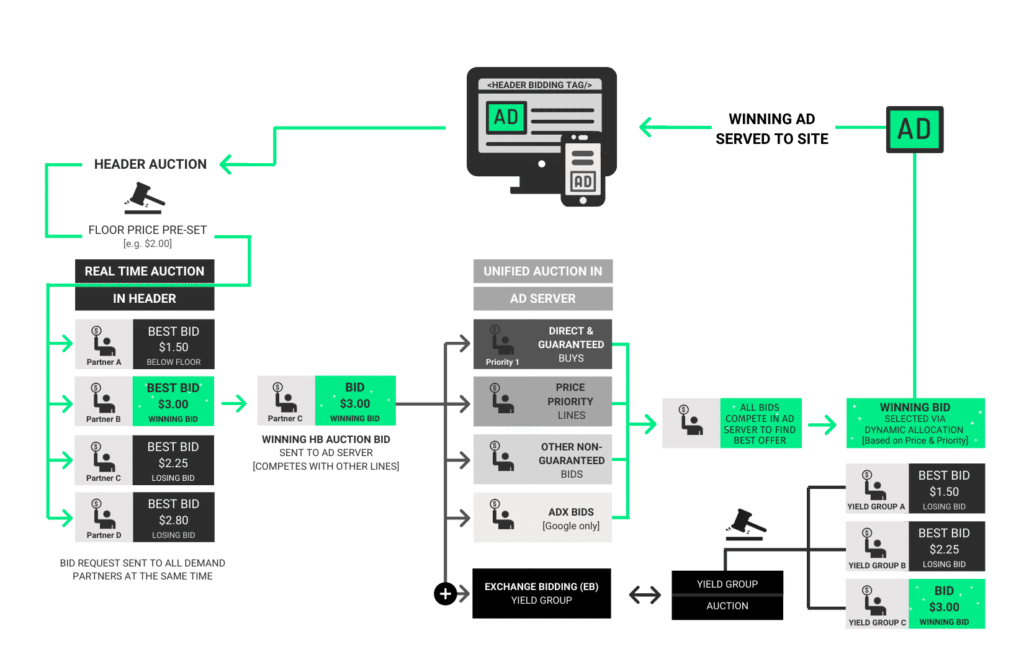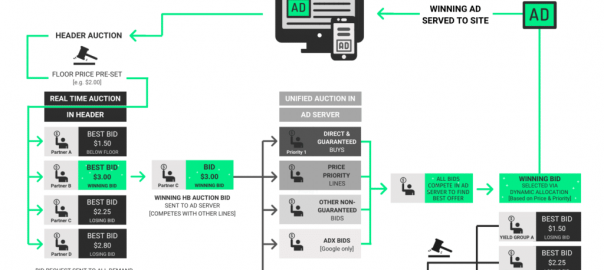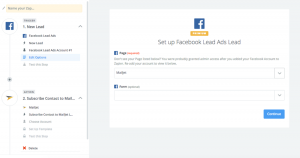If you’ve ever used online advertising, you might have heard of people raving about programmatic advertising.
And if up until now, you’ve been confused about how it is different from traditional advertising, or you wanted to better understand programmatic advertising vs Google Display Network, you’re in luck.
In this post, we’ll break down both Google Display Network and Programmatic advertising, explain their key differences, and evaluate why one is better than the other.
Let’s get right into it:
What is Google Display Network?
While you may not notice the Google display network actively, you probably come across it every day. Google Display Network is a system that allows advertisers to reach their target audience while they’re using the internet – for example when checking emails, browsing on an e-commerce product, watching youtube, using social media or their mobile apps.
In simpler words, the GDN can get your ads in front of targeted audiences across the web. It’s actually a very powerful system that reaches over 90 percent of internet users and 2 million websites across the web.
The display network, however, is a passive approach to advertising. It integrates your ads into carefully selected websites, where ads become reachable to users while they’re shopping, reading, or browsing.
What is Programmatic Advertising?
Programmatic advertising is a more automated approach to displaying ads. In programmatic advertising, there is automated selling and buying of ads using the software.
In simpler words, there is the use of software for buying and selling ads. Whereas, in the conventional approach, there’s a lot of manual processes like requesting proposals, quotes, tenders, and human negotiation. Instead of all this, programmatic ads just rely on machines and algorithms to buy and sell digital space.
With programmatic advertising, a lot of unnecessary manual work is removed, and thus, humans have more time for optimizing and improving ads.
How Does The Google Display Network Work?
The Google Display Network acts as an interface between the publisher and the advertiser. Advertisers are using this platform for choosing their target audience based on interest, domain, demographic, and other important criteria. Furthermore, they get complete control over ad placements, ad scheduling, and other such processes within a website.
Ad placement can be for a specific website, a mobile app, an individual ad unit, or a specific page on a site. For example, you can use GDN to target women from the U.K above the age of 20 who visit pages related to ‘skincare’.
How Does Programmatic Advertising Work?
As we mentioned earlier, programmatic advertising automates the whole process – rendering the need for manual work. There is no middleman in the form of an ad network.
If you’re an advertiser, you’ll simply have to use a software called ‘Display-side platform’ to enter the audience demographic (and other segments) you want to target. And if you’re a publisher, you’ll use a software called ‘Supply-side platform’ to convey that you’ve available ad inventory.
There is no need to send ad placement requests, negotiate, or any manual work as such. Once a visitor enters a website, ad exchanges are notified about it. If the audience matches the specification of the target audience chosen by the advertiser, you automatically enter an auction with other advertisers.

Source: leading.vn
The advertiser who made the highest bids gets the ad slot and their ads are shown on the webpage. Similarly, each ad space is sold on a real-time bidding basis, and yet all of this happened automatically in milliseconds.
How Are GDN & Programmatic Advertising Similar?
Few key elements are similar in both these networks. For example, the concept, placement, and targeting. Both programmatic advertising and GDN are auction-based bidding platforms that utilize display ads for reaching a target audience.
Similarly, both these networks allow marketers to reach the website and mobile application placements. And at their core, both these platforms offer shared basic targeting options. Hence, the users are able to target specific audiences on the basis of site topics, behaviors, demographics, and remarketing.
How Are GDN & Programmatic Advertising Different?
Despite the similarity, both GDN and programmatic advertising have distinct differences. Both these networks have advantages and disadvantages of their own. In this section, we’ll go through each key feature and understand the differences:
1. Programmatic Advertising vs Google Display Network: Ad Variety
If you’re wondering which of these support more variety in terms of ad types, know that both GDN and programmatic advertising support all major ad creatives – including the videos, images, rich-media ads, and HTML5.
However, when it comes to rich-media ads Google Display Network lags behind. A huge number of GDN publishers don’t support this technology on their websites. On the other hand, DSPs are good at displaying rich-media ads.
Considering how rich-media ads are gaining popularity as a super interactive ad format, you may want to opt for programmatic advertising.
2. Programmatic Ads vs GDN: Reach
You might have known this – the Google Display Network has a huge audience base. The tool provides access to a vast number of websites that have partnered with Google. This amounts to almost 70% of the websites on the internet.
However, this number is still lesser than what a DSP can offer. Prepare to be wowed!
Yes, programmatic advertising software can give you access to all of the GDN’s inventory plus inventories from other ad exchanges such as Adscale, Rubicon project, and more. This would sum up to be around 95% of the internet.
Hence, if you want to get a wider reach, there’s no doubt that programmatic advertising can enable that.
3. Programmatic Ads vs GDN: Targeting
Both programmatic ads and GDN offer decent targeting options. You can target your ads to audiences on the basis of keywords, topics, interests, and demography.
Through keyword targeting, you can select keywords relevant to your ad message. Through topic targeting, you can choose topics relevant to your ads. Similarly, with interest and demographic targeting, you can choose the interest, age, and location of your target audience.
The only difference between the targeting approach of GDN and programmatic ads is the data used for targeting. While the GDN uses Google search data for targeting users, programmatic ads use many third-party agents to employ more in-depth data.
So, in terms of targeting, programmatic advertising is a little more advanced than GDN.
4. Programmatic Ads vs GDN: Pricing
If you choose Google Display Network, you get multiple pricing options, including:
- CPC: Cost is decided for each click.
- CPM: Cost is decided for every thousand impressions.
- CPA: Cost is tied to a particular action – for example, signing up, downloading an ebook, or trying a free trial.
And if you choose programmatic advertising, there’s only one option, and i.e., CPM.
The cost per mille (CPM) is calculated using this formula:
CPM = Ad spend/Ad impressions x 1000.
5. Programmatic Ads vs GDN: Cost Effectiveness
Most programmatic advertising software (DSPs) require a minimum ad spending of approx $ 5000 to $ 10000 per month – only then can it be maintained free of cost. So, if you don’t spend that much, you’ll have to pay a minimum fee – this varies from contract to contract.
However, in the Google Display Network, there is a rule as such. There’s no minimum spend that is expected of you. Hence, if you’re just starting out, GDN would be a more cost-effective option as compared to DSP. We’d recommend you to first try GDN, make some money, and then invest in DSP.
6. Programmatic Advertising vs Google Display Network: Video Advertising
Again, both programmatic advertising and Google Display Network support video advertising. But, in GDN the video ads are limited to YouTube. Hence, you have a limited audience to target.
On the other hand, programmatic advertising offers platforms other than YouTube – enabling you to reach more audiences.
Which One Should You Choose?
There you have it – all the major differences between Programmatic Advertising vs Google Display Network.
The GDN is a great choice for marketers who’re just starting out and want to keep it simple. There’s no cost barrier, plus it’s easy to use. Furthermore, GDN directly integrates with Google Product Suite – enabling access to Drive, Google Calendar, and Gmail. Additionally, you can use the tool to target an audience based on their Google search history.
Programmatic advertising, on the other hand, offers an increased distribution scale, enabling reach to 20+ ad exchanges. So, with programmatic, you have more control over creative placement, audience targeting, and retargeting options as well. Furthermore, it allows for advanced targeting options like behavioral advertising, in-store attribution, and location-based advertising.
The Bottom Line
Despite the learning gap and cost, programmatic advertising is a better option if your budget allows it. After all, it gives you more control, better targeting capabilities, and a wider scale. But this doesn’t mean GDN is bad. If you’re on a small budget, GDN is a super cool alternative with a lower entry cost.
Whichever you choose, the important thing is that you have a clear vision, great content, and a strong marketing strategy behind your advertising efforts.
Digital & Social Articles on Business 2 Community
(89)









